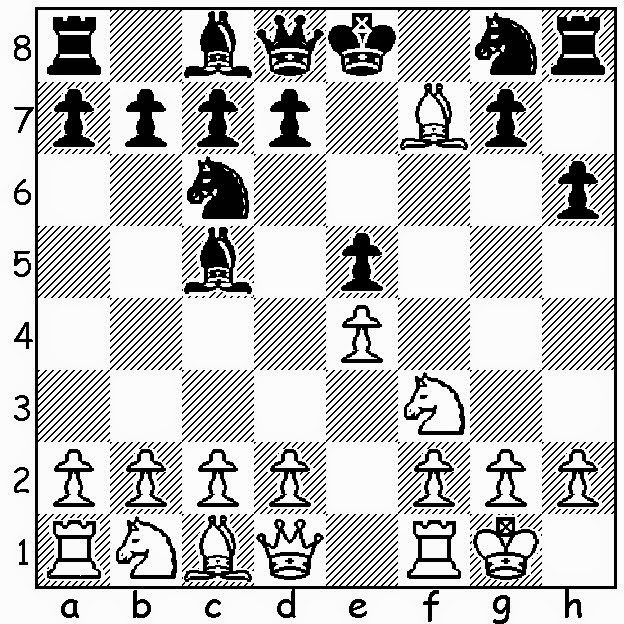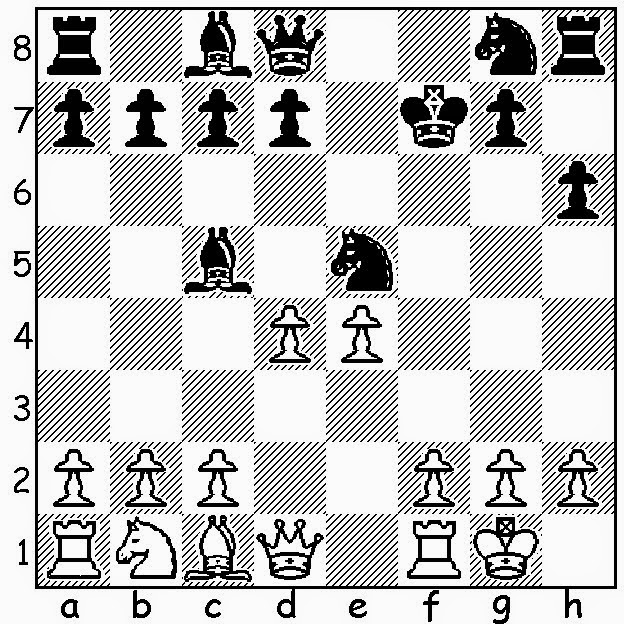I was looking for a short Jerome Gambit game to share with Readers, and stumbled upon an "old colleague" - a line of play that keeps showing up, regardless of expectations.
KAVUA - wojowhiskey
standard, FICS, 2013
1.e4 e5 2.Bc4 Bc5 3.Nf3 Nc6 4.Bxf7+
4...Kxf7 5.Ng5+
I was surprised to note that this line has been seen in 445 games in The Database. Amazingly, the natural response, 5...Qxg5, was seen in only 318 of those games.
The first mention of the line on this blog was in "A Closer Look (Part I)" 2008 when I noted that
"The in-your-face 5.Ng5+ was championed by tournament winner Carlos Azcarate (see "Carlos Azcarate Topping Ninja Knights T3") to the tune of one win and four losses."
A year later, when talking about 4 more examples in "Eyeblink Chess: Crash", I wrote
"Relax, readers. This blog, and the support of the Jerome Gambit Gemeinde will help you avoid such crashes."
Alas, it was not to be. The following year "Opening Tale" featured bit of a mystery involving a player who wanted to know what to do, after losing to 5.Ng5+ (put forward by one of the Jerome Gambit Gemeinde).
"..I'm pretty bad at openings I don't know, and lower rated opponents beat me at these, here's a worst case example:"
Later on in 2010, "Death of A Variation" pointed out that
"DREWBEAR 63's only loss to date in the ongoing Jerome Gambit Thematic Tournament at ChessWorld came with the White pieces against his primary rival, Daves111, under unclear circumstances."
[Daves111 finished first in the tournament with 21 points; DREWBEAR 63 tied for second with 17 1/2 points.]
"Theory From the Thematic Tourney (2)" in the same year presented 5 more games with the line, including 2 wins by White
To reinforce my message, I posted "Reinventing the Flat Tire" making it clear that the line was
"Outrageous, even by Jerome Gambit standards. On the surface, White hopes to exchange his Knight for Black's Bishop at c5 – but the game quickly becomes too chaotic for that."
All the games mentioned to date were played online at FICS, but during 2011, in "Relayed Deaction" I was able to post an over-the-board example of the line from the Nana Alexandria Cup, Poti, Georgia, 2009.
I posted my first PSA later, "Public Service Announcement" with 5 games.
In 2012, I pointed out that "A Mention Is Not An Endorsement".
Even as recently as this year, in "Truth Is Stranger Than - Whatever" I opined
"This move seems to throw away a piece. I much prefer that White throw away a piece, instead, with 5.Nxe5. Even the Jerome Gambit has its limits."6.d4
This is White's "plan"...
6...Bxd4 7.Bxg5 Black resigned.
...And it worked to perfection.
Of course, it would only be fair to point out that Black's alternative, 6...Qxg2, wins crushingly.









































